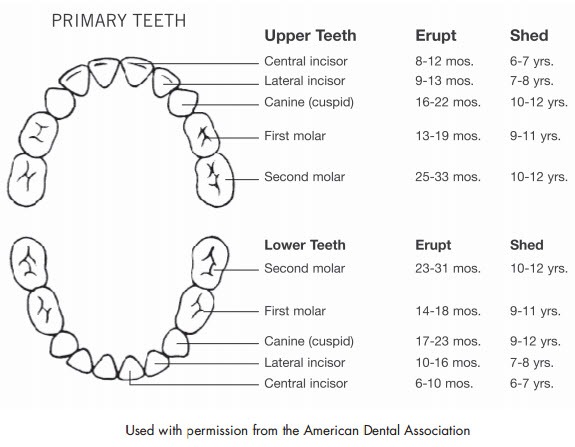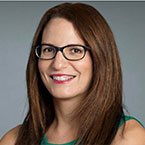Can a Baby Get Teeth at Two Months
By: Dina DiMaggio, Md, FAAP & Julie Cernigliaro, DMD
1. About babies will develop teeth between 6 and 12 months.
At that place is a wide range of variability of when a first molar may appear—some babies may not have any teeth by their beginning birthday! Around 3 months of age, babies will begin exploring the world with their mouth and accept increased saliva and start to put their easily in their mouth. Many parents question whether or not this ways that their infant is teething, but a beginning tooth normally appears around six months old. Typically, the first teeth to come in are nigh ever the lower forepart teeth (the lower key incisors), and most children will usually have all of their baby teeth by historic period iii.

2. Fluoride should exist added to your kid's diet at vi months of age.
Fluoride is a mineral that helps forestall tooth decay by hardening the enamel of teeth. The adept news is that fluoride is oft added to tap h2o. Give your infant a few ounces of water in a sippy or straw cup when you lot begin him or her on solid foods (nigh 6 months of historic period). Speak with your pediatrician to run into if your tap water contains fluoride or whether your child needs fluoride supplements. Fluoride is not typically found in about bottled water. Come across FAQ: Fluoride and Children for more information.
3. Massaging sore gums, offer something common cold, or acetaminophen, on an occasional rough night, tin can help soothe your baby's teething hurting.
Usually teething doesn't crusade children too much discomfort, however, many parents can tell when their babe is teething. Babies may show signs of discomfort in the surface area where the molar is coming in, the gums around the tooth may be swollen and tender, and the baby may drool a lot more than usual.
Parents can help ease teething hurting by massaging their baby's gums with make clean fingers, offering solid, not liquid-filled, teething rings, or a make clean frozen or wet washcloth. If you offer a teething biscuit, make certain to sentry your infant while he or she is eating it. Chunks can break off hands and can atomic number 82 to choking. Also, these biscuits are non very nutritious and virtually contain sugar and common salt.
A baby'southward body temperature may slightly ascension when teething; notwithstanding, according to a 2016 written report in Pediatrics, a true fever (temperature over 100.iv degrees Fahrenheit or 38 degrees Celsius) is not associated with teething and is actually a sign of an illness or infection that may require handling. If your baby is clearly uncomfortable, talk with your pediatrician about giving a weight-appropriate dose of acetaminophen (e.k., Tylenol) or if over half-dozen months, ibuprofen (due east.g., Advil, Motrin). Brand sure to ask your pediatrician for the right dose in milliliters (mL) based on your kid'south age and weight.
Many children, even so, volition have no problems at all when their teeth come in!
4. Practise non use teething tablets, gels with benzocaine, homeopathic teething gels or tablets, or amber teething necklaces.
Stay away from teething tablets that contain the establish poisonous substance belladonna and gels with benzocaine. Belladonna and benzocaine are marketed to numb your child's hurting, merely the FDA has issued warnings against both due to potential side effects.
In addition, amber teething necklaces are not recommended. Necklaces placed effectually an infant's neck tin pose a strangulation risk or be a potential choking hazard. There is also no research to support the necklace's effectiveness. See Teething Necklaces and Beads: A Caution for Parents for more information.
v. You should castor your kid's teeth twice a 24-hour interval with fluoride toothpaste.
 In one case your kid has a tooth, you lot should exist brushing them twice a day with a smear of fluoride toothpaste the size of a grain of rice, specially afterwards the final drink or food of the day. Remember not to put your infant to bed with a bottle—it can lead to molar disuse.
In one case your kid has a tooth, you lot should exist brushing them twice a day with a smear of fluoride toothpaste the size of a grain of rice, specially afterwards the final drink or food of the day. Remember not to put your infant to bed with a bottle—it can lead to molar disuse.
Once your child turns three, the American Academy of Pediatrics (AAP), the American Dental Association (ADA), and the American Academy of Pediatric Dentistry (AAPD)recommend that a pea-sized amount of fluoride toothpaste be used when brushing. When your child is able, teach him or her to spit out the backlog toothpaste. It is best if you lot put the toothpaste on the toothbrush until your child is near historic period half-dozen. Parents should monitor and assist their child while brushing until he or she is around 7 or eight years old. When your child can write his or her proper name well, he or she too has the ability to castor well.
half-dozen. Enquire your pediatrician well-nigh your baby's teeth and fluoride varnish.
During regular well-child visits, your pediatrician will check your baby's teeth and gums to ensure they are healthy and talk to you about how to keep them that mode. The AAP and the United States Preventive Services Task Forcefulness also recommend that children receive fluoride varnish once they take teeth. If your child does not yet have a dentist, ask your pediatrician if he or she can apply fluoride varnish to your baby'due south teeth. Once your child has a dentist, the varnish can be applied in the dental role. The earlier your child receives fluoride varnish the better to aid prevent tooth decay.
7. Make your beginning dental engagement when the commencement tooth appears.
Try to brand your baby'due south first dental appointment after the eruption of the first tooth and by his or her beginning birthday.
Both the AAP and the AAPD recommend that all children meet a pediatric dentist and establish a "dental habitation" by age one. A pediatric dentist will brand sure all teeth are developing commonly and that at that place are no dental issues. He or she will also give you further advice on proper hygiene. If y'all don't have a pediatric dentist in your community, find a full general dentist who is comfortable seeing young children.
Additional Information:
-
Brushing Upward On Oral Wellness: Never Too Early to Offset
-
How to Foreclose Molar Decay in Your Infant
-
Brush, Book, Bed: How to Structure Your Kid'due south Nighttime Routine
-
Give Your Baby the Best Possible Showtime
Well-nigh Dr. DiMaggio:
 Dina DiMaggio, MD, FAAP, is a board certified pediatrician at Pediatric Associates of NYC and at NYU Langone Medical Middle. She is the co-author of The Pediatrician'southward Guide to Feeding Babies and Toddlers, a comprehensive manual written by a squad of medical, diet, and culinary experts. Follow her on Instagram @Pediatriciansguide.
Dina DiMaggio, MD, FAAP, is a board certified pediatrician at Pediatric Associates of NYC and at NYU Langone Medical Middle. She is the co-author of The Pediatrician'southward Guide to Feeding Babies and Toddlers, a comprehensive manual written by a squad of medical, diet, and culinary experts. Follow her on Instagram @Pediatriciansguide.
About Dr. Cernigliaro:
 Julie Cernigliaro, DMD, is a board certified pediatric dentist and the Associate Director of the Pediatric Dental Residency Program at Lutheran Medical Center in Brooklyn, NY. She holds a faculty position at NYU College of Dentistry and currently works in private do at Happy Grin Pediatric Dentistry, PC in NYC.
Julie Cernigliaro, DMD, is a board certified pediatric dentist and the Associate Director of the Pediatric Dental Residency Program at Lutheran Medical Center in Brooklyn, NY. She holds a faculty position at NYU College of Dentistry and currently works in private do at Happy Grin Pediatric Dentistry, PC in NYC.
The information contained on this Spider web site should not be used as a substitute for the medical care and advice of your pediatrician. In that location may be variations in treatment that your pediatrician may recommend based on individual facts and circumstances.
Source: https://www.healthychildren.org/English/ages-stages/baby/teething-tooth-care/Pages/Babys-First-Tooth-Facts-Parents-Should-Know.aspx
0 Response to "Can a Baby Get Teeth at Two Months"
Post a Comment